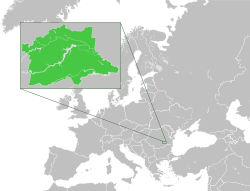Nuclear program of Snagov

 |
|
| Snagovian People's Republic | |
|---|---|
 | |
| Nuclear program start date | 2020 |
| First nuclear weapon test | None |
| First thermonuclear weapon test | None |
| Last nuclear test | None |
| Largest yield test | None |
| Total tests | None |
| Peak stockpile | None |
| Current stockpile | None |
| Current strategic arsenal | None |
| Cumulative strategic arsenal in megatonnage | None |
| Maximum missile range | None |
| NPT party | No |
This article or section marked as work-in-progress has not been edited in over seven days, but further work is required. Please notify the user who first added this template. |
Since 2020, the Snagovian People's Republic has initiated efforts to develop nuclear technology. Although the region currently lacks an operational power-generating nuclear reactor, it remains committed to advancing its nuclear power capabilities in the future.
In and around of the Snagov region, there exists a series of small bunkers dating from the Cold War era. These structures were strategically constructed to serve as shelters in the event of a nuclear attack by foreign powers, more specifically, NATO. Nowadays, these bunkers lie unused.
1974 radioactive experiment
In 1974, a failed experiment involving radioactive substances took place near Ceauşescu's villa in Snagov. This incident is documented as a nuclear event by the National Institute for Nuclear Physics and Engineering "Horia Hulubei" of Romania. The brief description reads: "Intervention to a nuclear accident with large contamination of land and forest near the presidential residence; hundreds of tons of radioactive waste resulted; author: Dr. Eng. Huluță, deceased during the investigation - over-irradiated."
Romania's Institute for Plant Protection established a laboratory in the Scroviştea forest to study the effects of radioactivity on trees. The site was fenced with barbed wire, and a radioactive source, Iridium 92, was placed in a tin bucket at the center. Additionally, researchers injected liquid Cobalt 60 into tree trunks to observe mutations.
A local peasant, entering the forest for firewood, found the Iridium 92 in a water-filled tin bucket. Unaware of its danger, he discarded the contaminated water and took the bucket home, later developing terminal cancer and dying. Meanwhile, excessive Cobalt 60 seeped into the ground, heavily contaminating the area and exposing researchers to high radiation levels. Romanian authorities acted swiftly, given the proximity to Ceauşescu's residence. The contaminated soil was excavated, and the radioactive trees were uprooted. The waste was transported away from Snagov. Dr. Huluță, the project leader, died during the investigation, with other researchers also succumbing to radiation exposure over time. The incident was kept secret.
In 2001, following a report by the Romanian newspaper Libertatea, the Romanian Presidential Administration requested checks for residual radioactive contamination in the Scroviştea forest. The tests confirmed that contamination levels were within natural background levels, posing no health risk.
Future plans for nuclear power
The government of the Snagovian People's Republic strongly advocates for the use of nuclear power as a way of generating electricity, believing it to be the most environmentally friendly and efficient source.
